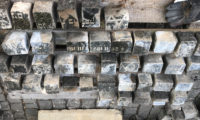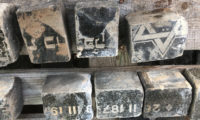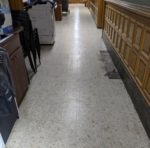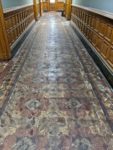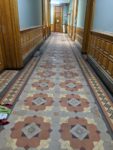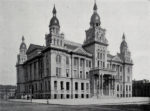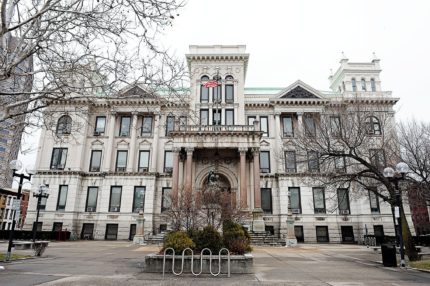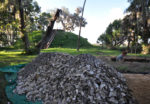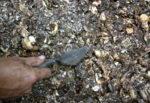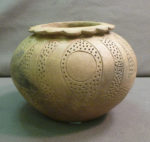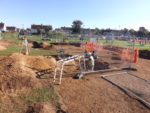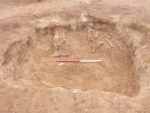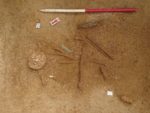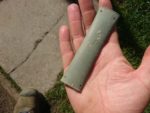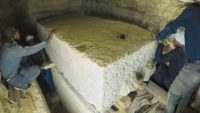 Analysis of the finds made in a mummification workshop discovered in the Saqqara necropolis has shed new light on the ancient Egyptian business of death.
Analysis of the finds made in a mummification workshop discovered in the Saqqara necropolis has shed new light on the ancient Egyptian business of death.
The mummification complex was discovered in near the 5th Dynasty Pyramid of Unas, between the pyramids of Sekhemket and Djoser. It is far newer than the Old Kingdom pyramid complexes, dating to the 26th Dynasty (ca. 664-525 B.C.). A central shaft 40 feet deep was discovered in 2018. Archaeologists had to remove 42 tons of sand and rock filling the shaft before reaching a large chamber with a high ceiling. It too was filled with sand and rocks, but scattered in the fill were thousands of pottery fragments.
 Once the chamber was cleared of all debris, archaeologists realized it was not a tomb, but rather a workshop for the mummification of the dead. It had a large incense burner, drainage channels for blood and a natural ventilation system, key features for dealing with the effluvia and smells of dead bodies.
Once the chamber was cleared of all debris, archaeologists realized it was not a tomb, but rather a workshop for the mummification of the dead. It had a large incense burner, drainage channels for blood and a natural ventilation system, key features for dealing with the effluvia and smells of dead bodies.
The room had a raised, table-like area and shallow channels cut into the bedrock along the base of one wall. In one corner, a barrel-sized bowl was filled with charcoal, ash, and dark sand. An older tunnel—part of a network of passages that honeycomb the rock beneath Saqqara—moved cool air through the space.
The pottery fragments have proven to be a treasury of information as well.
Over the past year, pottery experts were able to piece together the ceramic sherds, reconstructing hundreds of small bowls and jars, each one inscribed with a label.
“Every single cup or bowl has the name of the substance it held, and the days of the embalming procedure it was used,” [University of Tübingen Egyptologist Ramadan] Hussein says. “Instructions are written directly on the objects.”
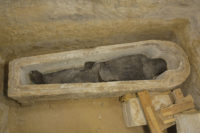 These finds are hugely significant because while the Egyptians left behind a great deal of information on their burial practices in writing and in paintings on tomb walls, very few mummification workshops have been discovered. When Egyptologists began scouring the sands for ancient remains, they were only interested in big ticket finds — pharaonic treasure, ideally. Working spaces were of no interest and were either overlooked or destroyed in the attempt to get into more “valuable” tombs.
These finds are hugely significant because while the Egyptians left behind a great deal of information on their burial practices in writing and in paintings on tomb walls, very few mummification workshops have been discovered. When Egyptologists began scouring the sands for ancient remains, they were only interested in big ticket finds — pharaonic treasure, ideally. Working spaces were of no interest and were either overlooked or destroyed in the attempt to get into more “valuable” tombs.
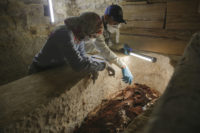 Adjacent to the mummification workshop, in 2018 archaeologists discovered a burial shaft 100 feet deep with five chambers branching off from the bottom. It too dates to the 26th Dynasty. Inside were the remains of more than 50 mummies and skeletonized individuals, five massive sarcophagi, alabaster canopic jars, thousands of shabti figurines and a gilded silver funerary mask that was the first of its kind found in 50 years. After more than a year of excavation, a sixth chamber has now been found hidden behind a stone wall.
Adjacent to the mummification workshop, in 2018 archaeologists discovered a burial shaft 100 feet deep with five chambers branching off from the bottom. It too dates to the 26th Dynasty. Inside were the remains of more than 50 mummies and skeletonized individuals, five massive sarcophagi, alabaster canopic jars, thousands of shabti figurines and a gilded silver funerary mask that was the first of its kind found in 50 years. After more than a year of excavation, a sixth chamber has now been found hidden behind a stone wall.
The sixth chamber contained four wooden coffins, one of whom belonged to a woman named Didibastett. While her coffin (and the other three) was in poor condition, a very unusual, even unique, feature caught the team’s attention: she had six canopic jars used to contain her embalmed organs. Standard mummification custom was to embalm only the lungs, liver, stomach and intestine which were then stored in four separate jars under the protection of the four sons of Horus. CT scans of the jars found that the two supernumerary ones do contain human tissue, exactly what kind is not yet known. A radiologist is examining the scans to identify which of Didibastett’s organs were embalmed against customary practice.
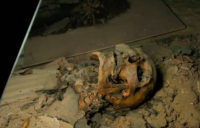 Perhaps she had a special contract with the folks at the mummification workshop, as the people interred in the deep shaft tomb — from the wealthy in expensive limestone sarcophagi to middle class Egyptians in wooden coffins to labourers simply wrapped in linen — were buried and their spiritual maintenance tasks performed by the embalmers. The mummification process, burial of the body and ongoing ritual upkeep of the dead were all revenue streams for the embalmers who were paid in cash or land by the surviving families. They offered a variety of packages for any budget.
Perhaps she had a special contract with the folks at the mummification workshop, as the people interred in the deep shaft tomb — from the wealthy in expensive limestone sarcophagi to middle class Egyptians in wooden coffins to labourers simply wrapped in linen — were buried and their spiritual maintenance tasks performed by the embalmers. The mummification process, burial of the body and ongoing ritual upkeep of the dead were all revenue streams for the embalmers who were paid in cash or land by the surviving families. They offered a variety of packages for any budget.
Ancient Egyptian society included an entire class of priests dedicated to caring for the spirits of the dead. Their job description included maintaining tombs and praying for their departed owners. Some owned dozens of tombs, with hundreds of mummies packed into each one.
“People had to bring weekly offerings to the dead to keep them alive,” says Koen Donker van Heel, an Egyptologist at the University of Leiden who has spent years studying the legal contracts priests signed with the families of the dead. “Dead people are money. That’s basically it.”
The excavation of the Saqqara workshop and its finds will be explored in Kingdom of the Mummies, a four-part series on National Geographic starting May 12th in the US and going global next month.
